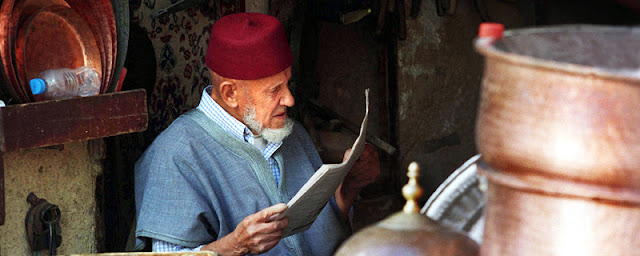Morocco in solidarity with Ebola affected countries
With the suspension of Air France flights to Sierra Leone, Morocco is being praised for being the last country to provide flights to the three main countries affected by the outbreak of Ebola.
On Thursday, after the decision by Air France, the World Health Organization (WHO) said it was "vital" that airlines would resume flights as soon as possible so as not cut Sierra Leone, Liberia and Guinea-Conakry off from the rest of the world.
Only the national carrier Royal Air Morocco (RAM) continues to operate 12 scheduled flights a week into these three countries.
"We are in a supportive and non-mercantilist approach that echoes the ongoing commitment of the kingdom to Africa," said RAM spokesman Challot Hakim,. He also noted that the current profitability of these destinations was zero, with flights in and out of Casablanca being at no more than 10% capacity .
Along with this decision the government ensures that all health safeguards have been taken.
The Ebola virus continues to spread in a "fast fashion" according to the World Health Organization (WHO). The WHO review released on Thursday, 28 August identifies 1552 deaths and 3,069 patients. For comparison, a week earlier, the figures were 1,427 fatalities and 2,615 patients. WHO now predicts that the Ebola virus will affect at least 20,000 people. And will likely more than 10,000 deaths. According to the UN agency, "more than 40% of the total number of cases occurred in the last three weeks" .
Dr. David Nabarro, the UN coordinator appointed against the Ebola virus, and Dr. Keiji Fukuda, deputy director of WHO's health security, have estimated it would take at least six months to stop the epidemic of qualified '"uncontrollable" by Médecins Sans Frontières (MSF).
"The international health community has been slow to react," wrote Anja Wolz, MSF emergency coordinator in Sierra Leone, in the
New England Journal of Medicine .
Casa - Fez train derailment "due to human error"
The derailment last Wednesday at Zenata of the Casablanca-Fez train, "was due to human error," said the Office National des Chemins de Fer (ONCF), stating that "the driver and the conductor of train did not comply with "the protection signals "and that the employee who died" had no responsibility for the accident."
The investigation by a commission of experts from ONCF revealed that "a freight train from Ain Sebaa was normally proceeding on a service line at Zenata. Thus, the signaling system automatically put the protection signal in the stop position".
"The driver and the conductor of train did not comply with this signal and crossed at high speed despite the action of the emergency brake. This caused the derailment of the train and due to its momentum it slid about 300m and hit a contributor and an empty car parked on adjacent tracks, "the statement said.
North Africans prefer a beer
The World Health Organisation has published its latest report on worldwide consumption of alcohol. Viewed from an international perspective, the figures for the Maghreb are not alarming.
In North Africa the figures put Tunisia in top spot where consumption has grown from 1.4 litre per person in 2003-2005 to 1.5 litres in 2008-2010. Algeria is in second place an annual average of with 1 litre of alcohol per person on average. This figure remains the same as it was back in 2003. The most surprising thing about the Algerian figures is that it is now the country with the highest alcohol consumption in the Maghreb.
Morocco comes in in third place with a slight increase (0.9%) on the figures from 2003-2005 to 1.5 litres in 2008-2010. The figure is suspect as some Moroccan information is missing. Morocco does not release statistics or information concerning tax revenue on spirits, wine and beer.
An interesting statistic that emerges from the WHO figures is just how much the three Maghreb countries in the survey like their beer. Tunisian beer consumption accounts for 68% of all alcohol consumed. In Algeria it is 63% and and finally 44% in Morocco.
The differences between the countries are more stark when it comes to wine. While not being as popular as it is in France (56%) Moroccans take top spot with 36% followed closely by Algeria where wine accounts for 35% of alcohol consumption and Tunisia on 38%.
The least consumed alcohol in all three countries remains spirits - Morocco 20%, Tunisia 4% and Algeria below 2%.
In comparison to the rest of the world the inhabitants of the Maghreb are very moderate drinkers. The religious aspect of Muslims drinking is explained by Moroccans as an understanding that the Holy Koran does not specifically forbid the consumption of alcohol but rather it forbids becoming intoxicated.
Contemporary art exhibition in Asilah
The MAC EXPO 2014 International Symposium of Contemporary Art in Asilah continues until September 20. Organized by the Association for Art and Culture (APAC), this exhibition brings together painters and contemporary sculptors from different cities of Morocco and from around the World.
Of particular note is the House of Contemporary Art located on the beach at Briech (6 km on the road to Tangiers). The MAC Expo helps strengthen exchanges between artists and intellectuals and artists from both sides of the Mediterranean and Middle East. Among the artists exhibiting include Mohammad Al Jaloos (Jordan), Mohamed Abou El Nagua (Egypt), Sami Ben Ameur (Tunisia), Christine Kertz (Austria), Nadira Mahmoud (Oman), Enzo Marino (Italy), Ali Rashid (Netherlands / Iraq), Diego Moya (Spain) and Moroccans Bouragba Omar, Ahmed Jaride, Tawfiq Chichani, Ahlam Lemseffer and Abdelkrim Ouazzani.
The House Contemporary Art is a cultural arts center that features a gallery and artists residence. For more Asilah Information: 0661.460648
Dates for Moroccan school year
The 2014-2015 school year is scheduled to commence on Wednesday, September 10 for primary schools and Thursday, September 11 for college and high schools.
The school year for students in the second year of preparatory classes at higher technician certificate (BTS) is also scheduled for September 11 while students in the first year of the BTS preparatory classes begin the school year Monday, September 15, 2014 and preparatory classes will begin Monday, September 8.
Back to school for teaching and administrative staff is set, meanwhile, for the first Monday in September, while for teachers, it is scheduled for Tuesday, September 2.
Tourism growth in Marrakech
Tourism in Marrakech is booming again. According to a report from the CRT (Regional Tourism Centre) the city has seen over 1 million arrivals in the first seven months or 2014
CRT Statistics indicate that the 1,084,305 arrivals is an increase of 9.06% over the same period the previous year.
The number of bed nights sits at 3,093,065 an increase of 11% and the occupancy rate of hotels has risen to 53% with an attendance rate that reaches 84%.
The 14 main clubs and entertainment centres in Marrakech are showing a variable occupancy rate between 60% to 90%.
Forecasts until December indicate a good year for tourism establishments in Marrakech with no fewer than 35 conferences, international events and festivals planned in the next five months.
As the top tourist destination in Morocco, Marrakech has 175 registered hotels and 980 guest houses. Marrakech represents 48% of the capacity of national accommodation and 42% of overnight stays at a national level.
~ SUNDAY OPINION ~
THE BURKA AND BURKINI ARE NOT MOROCCAN!
The New Tribune (La Nouvelle Tribune) has created something of a storm with its discussion about the burka in Moroccan society
New Tribune recently conducted a photo shoot on the beaches of Morocco that appeared to show a resurgence of full burkas and in some cases "burkinis" (female "Islamic" bathing costumes invented in Australia -
see story here).
The news site says that after publishing its findings on social networks they received a drubbing in comments from Internet users who accused them of being "mentally ill infidels" and asked the question "Why do you condemn the burka which is Moroccan and Muslim normality?"
The
New Tribune responded with an opinion piece by Zouhair Yata in which he points out that Moroccan women are free to wear what they want but notes that the burka and Burkini are not the characteristics of Moroccan Islam. Instead they are concrete evidence of a behavioral disruption of those in Moroccan society influenced by Saudi Wahhabism, which according to Mr Yata is promoted specifically by the explosion of satellite TV programmes in Morocco over the last twenty years.
The journal goes on to say that Morocco has a strong Muslim tradition, as expressed by our commitment to the Sunnah in the Maliki rite and "Tarika ashaarîa." In addition, they point out that the King is not only the Head of State but also Commander of the Faithful and that in the public sphere, including the highest levels of the state including the Royal Family, the burka has never been adopted. Even the Islamist PJD does not require its female executives or spouses of its male executives to wear a hijab.
The
New Tribune article concludes that it time to choose sides. "Either we defend a Morocco steeped in our traditions and our vision of Islam, or we choose to be sheep who copy imported practices that do not fit us."
We must defend the achievements of the Kingdom because its openness means job creation and growth. We should rejoice in Morocco's tolerance and singularity because the alternative is to fall into the same chaos as Libya, Egypt, Syria, and Iraq with their very different set of values, traditions and a different vision of Islam.- New Tribune
Stereotypes anyone? Why Gulf Men Are Obsessed with Moroccan Women
Aziz Allilou, writing for Morocco World News, reports that a Saudi author has revealed in an article that Gulf men prefer Moroccan women rather than Middle Eastern women, due to the special charm they hold, saying Gulf women are themselves to blame rather than faulting the Gulf men for favoring Moroccans.
In the Middle East, the majority of women believe in the stereotypes that label Moroccan women as scheming witches plotting to ensnare rich Kuwaiti husbands by casting spells on them.
These stereotypes were even promoted on Arab Gulf TV channels, such as Kuwait’s Al Watan. The latter broadcasted the animated comedy series Bu Qatada and Bu Nabeel that portrayed Moroccan women using sorcery and witchcraft to seduce and lure Kuwaiti youngsters for marriage.
 |
| Saudi author Ghazi Abdul Aziz |
However, Saudi author Ghazi Abdul Aziz explained that the truth is far from these myths. He said that Gulf men’s obsession by Moroccan beauties can be explained by the two unbearable powers they hold: their “dazzling beauty and rich culture.”
“Gulf women’s culture is a blend of the desert’s customs and traditions, Eastern Islam teaching, luxury communities plus a lot of Indian and American spices, whereas the Moroccan women’s culture is of such a different power,” Ghazi Abdul Aziz wrote.
“It consists of the Amazigh customs and traditions, pride, the Arab Islam’s teaching plus some French spices… this makes the Moroccan women very different than the Middle Eastern women,” he continues.
SHARE THIS!





.jpeg)





























.jpg)









